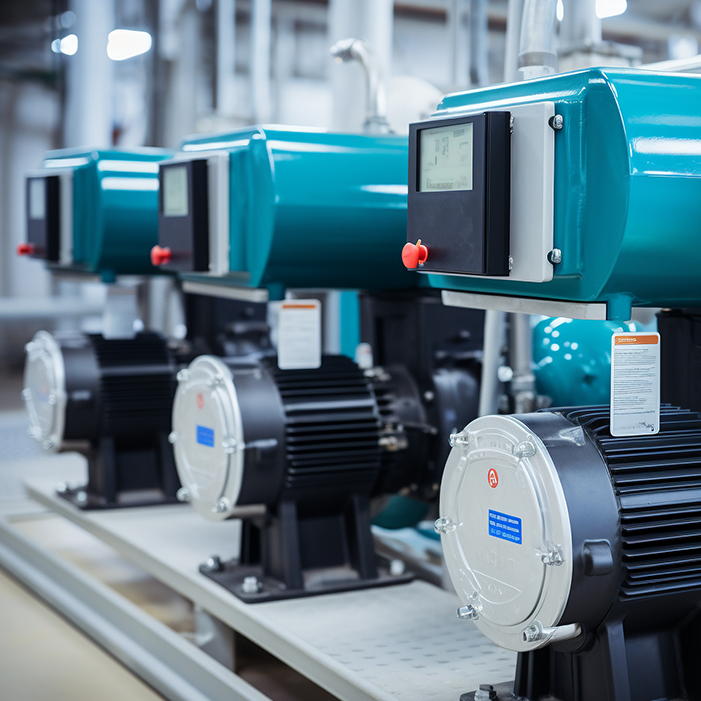Safety Notice
To avoid accident or damage, please be sure to read the Safety Notice carefully before use of the pump. Be sure to follow the safety instructions in this section. The Operating Instructions is very important and may prevent the pump operator or other people from injury or mitigate property damage.
1.Safety Warnings
1)Be sure to cut off the power supply before repair or other work. When there is someone repairing the pump, take protective measures to prevent other operators from switching on the power supply by mistake. In noisy or dark environment, place a clear sign beside the power switch to warn others. Switching on the power supply by mistake during maintenance may cause severe accident or even human death. Every person shall take special care.
2)Please wear safety goggles, protective gloves, protective clothes and other necessary protective equipment when replacing the pipe system or removing or assembling the pump.
3)When lifting the pump, use chain or belt to pass through the lug or motor to keep the pump and motor on level position. Do not stand beneath the lifted pump.
4)To avoid leakage, be sure to perform routine inspection and maintenance of the pump when it is used for transporting the following dangerous liquids. In the event of leakage, such dangerous liquids (or volatile gas) will cause explosion, hazard or human injury.
a)Inflammable or explosive liquids;
b)Corrosive or poisonous liquids;
c)Liquids harmful to human body.
2.Safety Cautions
1)Avoid idle run: Idle run may heat impeller axle and destroy the mechanical seal due to dry friction, thus resulting in damage to the pump. (It is also deemed idle run if the pump works with the inlet and outlet valve closed).
2)Avoid damage due to static charge: Static charges will be generated if the pump is uses for transporting the liquids of low conductivity, e.g. ultra-pure water or fluorine-contained inert fluids. This will cause electric discharge and damage to the pump. Measures shall be taken to prevent the generation of static charges or other measures shall be taken to lead the static charges.
3)The pump maintenance personnel shall have professional knowledge and operating experiences.
4)The centrifugal pump made of special materials shall be used for designated working conditions only; otherwise there is no way to ensure the normal performance and service life of the pump, or it may even cause accident.
5)Requirements for site ventilation: Safety measures must be taken if the pump is used for transporting the volatile poisonous gas. For example, ventilation equipment may be installed to avoid liquid leakage in case of emergency.
6)Avoid liquid leakage: To prevent the liquid from flowing directly into the ground, protective measures shall be taken against the leakage caused by emergency accident or pipe damage.
7)Select the electromagnetic switch according to the motor specification, e.g. rated voltage and rated power.
8)If the pump is installed outdoor, protective measures must be taken for the electric circuits, thus to prevent the water from flowing into the switch.
9)The electromagnetic switch and buttons shall be installed safely and away from the pump.
Introduction
1.Use and Features
This pump is widely used for transporting the acid, alkali, salt, oil, beverage and alcohol liquids. In detail, it is used for transporting the clear liquid or slurry such as sulfuric acid, hydrochloric acid, alkali and oil in chemical industry; transporting the acid, mineral slurry, mortar, electrolyte and sewage in leaching of non-ferrous metals; for transporting the sewage and slurry in water treatment and environment industry; and for acid wash in iron and steel industry. This pump can not only be an alternative for the metal and non-metal equipment in above industries, but also be a top priority for equipment localization. Features: Manufactured from UHMWPE, this pump features in superior performance of resistance to corrosion and wear (topping all plastics) and resistance to impact. The pump seal is available with oil seal and mechanical seal for option. It can not only transport the corrosive liquids containing tiny particles, but also transport the slurry containing solid particles and the sewage containing different substances. Particularly, it will demonstrate superior performance when used for transporting the corrosive liquids containing tiny particles and transporting other liquids such as hydrofluoric acid, fluosilicate acid, phosphoric acid, mixed acid, electrolyte, hydrochloric acid, dilute sulfuric acid and concentrated alkali.
2.Packaging and Inspection
Check the following after unpacking:
1)Check if the pump and its accessories (including the other documents required by the user) are complete as on the Packing List.
2)Check the data on the nameplate of the pump and motor to ensure if they conform to your order requirements.
3)Check if the pump is damaged during transport and if the bolts are loose.
3.Model Definition
UHB-ZK20/20-20
UHB: Symbol of polymeric material 20: Flow 20m3/h
ZK: Mark of usage mark, Z – Mortar containing foreign substances; K – semi-open impeller;
20: Head 20m 50: Pump inlet diameter 50mm
Model and Parameters (Continued)
Model and Parameters (Continued)
Model and Parameters (Continued)
Notes:
1)If the specific gravity of the liquid exceeds 1.3g/cm3, the user is suggested to add the motor power of as appropriate.
2)If the liquid contains HF acid or some special medium, it is needed to replace with special components according to the liquid properties.
3)If the flow under working condition is too low, return pipe shall be connected at outlet. For detail, please consult our Technology Dept.
5.Scope of Application
1)Pressure limit: The pressure limit is 1.0MPa. Take care that the output pressure of the pump shall not exceed the pressure limit.
2)Range of working temperature: -20~85℃; Variance of ambient temperature: 0~40℃; Variance of ambient humidity: 35~85%RH
3)The pump may be used to transport the clear liquid or the slurry containing particles (solid content≤20% and particle size within Ø3mm).
4)Impact of liquid viscosity to the pump performance: The pump performance varies with the liquid viscosity. Consult our Technology Dept. for detail.
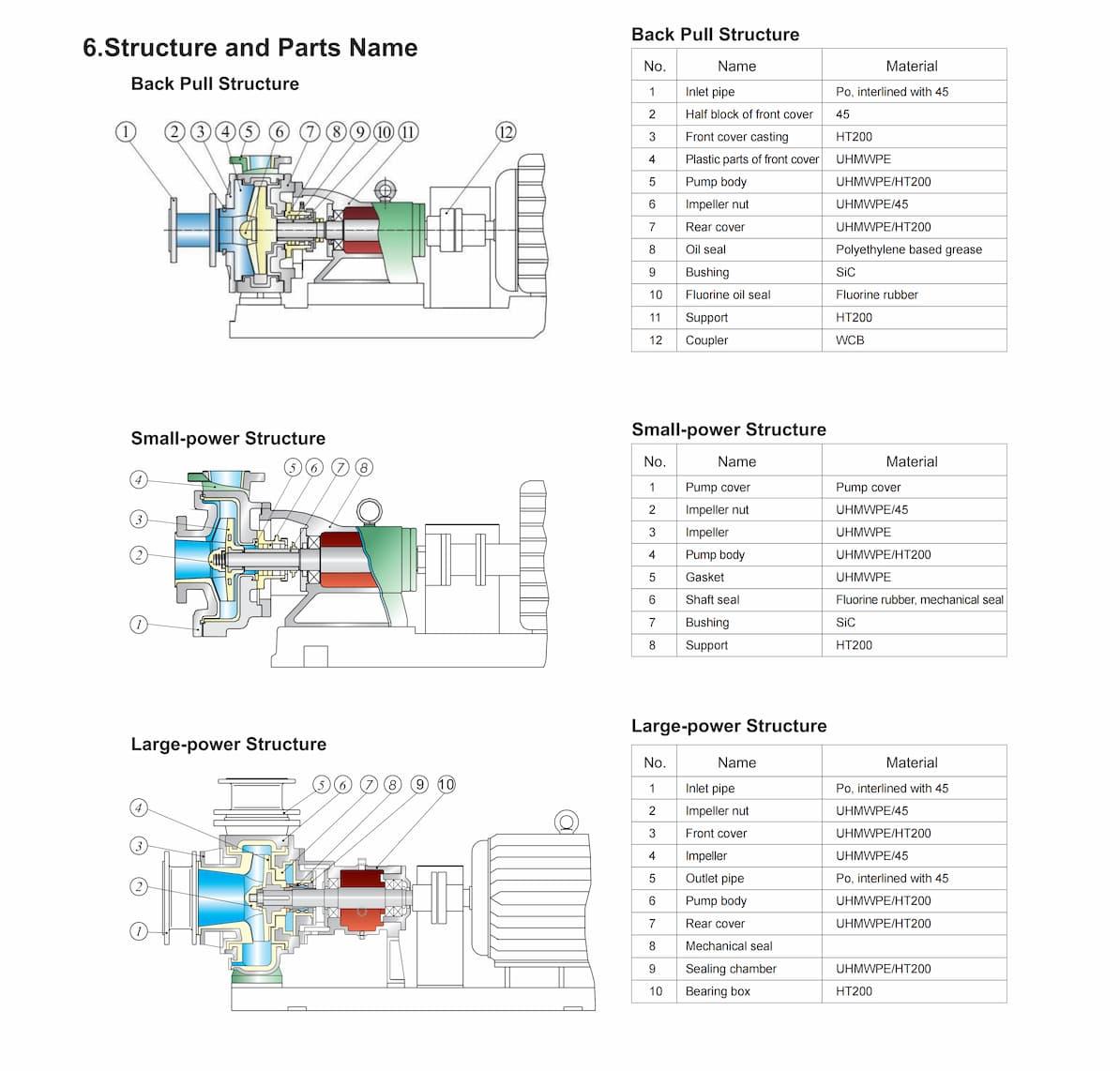
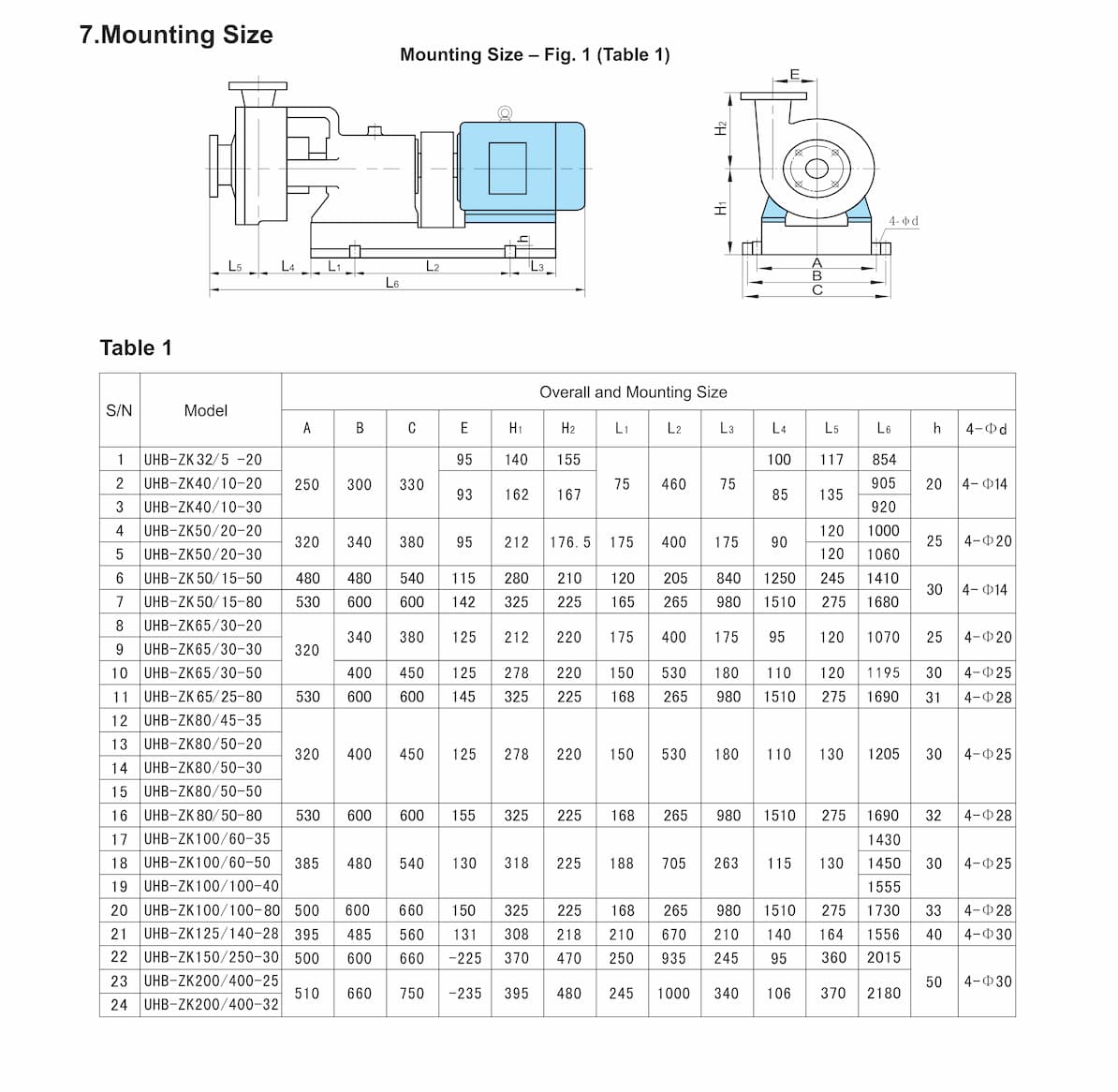
1.Key Points of Installation
1)The pump shall be installed and fixed on solid foundation free from the impact of mechanical vibrations.
2)The foundation shall weigh three (3) times the equipment weight or higher, and be larger than the seat.
3)For easy repair and maintenance, adequate space shall be left around the pump.
4)Place the pump unit on the foundation. Gaskets shall be paved between the seat and foundation.
2.Pipe
1)The pipes into and out of the pump shall be supported. Do not use the pump as the support. The pipe diameter shall be compatible to the pump opening. The pump shall be as close as possible to the water tank.
2)Ensure that the mounting height of the pump conforms to the NPSH. The pipe loss and medium temperature shall be also considered. To avoid NPSH within the pump body, be sure to follow the formula below:
NPSHa ≥ NPSHr + 0.5, in which:
NPSHa: Effective (equipment) NPSH (m)
NPSHr: Necessary (pump) NPSH (m)
3)The pipe bend shall be as smooth as possible. Minimize the bends and avoid bend at the position close to the pump inlet.
4)The liquid drop shall be considered. The suction pipe shall be positioned at an adequate depth.
5)When the pump is used for upward suction, bottom valve must be installed on the inlet pipe of the pump. When the pump is used for back flow, valve must be installed on the inlet and outlet of the pump. The valve mounted in the outlet pipe may be used for adjusting the flow to ensure that the pump works at the specified flow. This may avoid the pump failure due to motor overload. (Never use the inlet valve for adjusting the flow)
6)For easy repair, pipe compensator shall be installed at the inlet and outlet of the pump as it might be.
7)The pipe must be correctly connected. The sealing gasket between the flanges shall be smooth and not be mal-positioned. If there is leakage on the seal, the pump cannot work normally or the pump might be even damaged.
Operation and Maintenance
1.Cautions before Use
1)Idle run of the centrifugal pump shall not exceed 5 minutes (when connected to cooling water). The minimum flow of the pump during operation shall be 35% of the design value.
2)If cavitations occur when the pump is running, be sure to stop the pump within one (1) minute.
3)The variance of medium temperature shall be controlled within 40℃. If the temperature rise / drop are too high, it might cause damage to the pump components.
4)If there is sudden power failure when the pump is running, be sure to cut off the power supply immediately and close the outlet valve.
5)The pump noise is ≤85dB. If there is vibration or noise, please stop the pump and check it. Do not restart the pump until the trouble is eliminated.
2.Start and Operation
1)Start
(1)Check if the pump rotates in correct direction. Start by inch to confirm if the rotating direction is same as the marked direction.
(2)For the pump with oil-lubricated bearing, lubricating oil shall be firstly filled into the bearing box until it reaches the center position of the oil gauge. To keep the oil clean and good lubrication, the oil shall be replaced periodically. Generally, the oil shall be totally replaced every 1500 hours of operation. N46 machinery oil is preferred.
(3)When rotating the coupler with your hand, you shall feel easy and weight uniform. Also take care to identify there is friction or rolling noise inside the pump. If any, take measures to eliminate.
(4)For backflow condition, open the inlet valve to supply the liquid. For upward suction, be sure to fill the pump with liquids.
(5)Connect the cooling water for shaft seal. Start the motor to make the pump rotate. Then, open the outlet valve (you may open the valve for 1/4).
2)Operation
(1)To avoid damage to impeller or other components, never control the flow by closing or adjusting the inlet valve.
(2)Test run the pump for 5 – 10 minutes. If there is no abnormality, put the pump into normal operation.
(3)Regularly check the pump and motor for temperature rise. The temperature rise of bearing shall be not higher than 40℃ and the limit temperature shall not be higher than 90℃. For insulated motor, the maximum temperature rise shall be 90℃ when the ambient temperature is 40℃, and the tolerable limit temperature is 130℃.
(4)If the pump head is lower than the rated head, be sure to close the outlet valve smaller to make the flow reach the rated value. If the outlet valve is fully open, the flow will be higher than the rated value. To avoid cavitations, do not use the inlet valve for adjusting the pump flow.
(5)If finding abnormal sound or other problems during operation, please stop the pump immediately and check it. Do not restart the pump until the problems have been eliminated.
(6)If ceramic bushing is installed for dynamic seal, do not flush directly with cooling water during operation, thus to prevent the bushing from crack due to sudden drop of temperature. When several pumps are used centrally, do not use the same cooling water for all the pumps.
3)Stop
(1)Firstly close the outlet valve. Then, cut off the power supply of the motor.
(2)Close the inlet valve to stop supply of cooling water to the shaft seal.
(3)Keep the pump outer surface and environment clean.
(4)After the pump is stopped, if the ambient temperature is lower than the freezing temperature of the liquid, it is needed to discharge the liquid thoroughly from the pump, thus to avoid freezing.
(5)If the pump is long out of use, the corrosive liquid inside the pump shall be thoroughly discharged. Besides, the pump chamber shall be flushed clean with clear water. Take special care to flush the sealing components and block the pump inlet and outlet properly. Keep the pump in good condition.
3.Repair and Maintenance
1)Check the pump and motor regularly. Replace the easily-damageable components.
2)If the pump is stopped and placed long out of service, the flow passage inside the pump shall be flushed and the power supply shall be disconnected.
3)Always avoid idle run. If the pump is installed outdoor, rainproof measures shall be taken to prevent the motor from burn due to moisture.
4.Removal and Assembly
1)Back pull structure
(1)Loosen the bolts fixing the pump rear cover to pump body. Separate the pump rear cover from pump body.
(2)Loosen the impeller nut and lock nut (the thread is inverse to the pump rotating direction). Separate the impeller and pump shaft.
(3)Loosen the bolts fixing the pump rear cover to the support. Separate the pump rear cover from pump shaft (Oil seal and bushing are connected on the pump rear cover).
(4)Loosen the bolts fixing the oil seal to pump rear cover. Separate the oil seal from pump rear cover. Dismantle the oil seal, inlet ring and other parts.
(5)Loosen the bolts fixing the bearing gland to support. Separate the bearing, support and pump shaft.
2)Small-power structure
(1)Loosen the bolts fixing the pump cover to pump body. Separate the pump cover from pump body.
(2)Loosen the impeller nut and lock nut (the thread is inverse to the pump rotating direction). Separate the impeller and pump shaft.
(3)Loosen the bolts fixing the pump rear cover to the support. Separate the pump rear cover from pump shaft (Oil seal and bushing are connected on the pump rear cover).
(4)Loosen the bolts fixing the oil seal to pump rear cover. Separate the oil seal from pump rear cover. Dismantle the oil seal, inlet ring and other parts.
(5)Loosen the bolts fixing the bearing gland to support. Separate the bearing, support and pump shaft.
3)Large-power structure
(1)Loosen the bolts fixing the inlet / outlet pipe to the pump body. Separate the pump body from inlet / outlet pipe.
(2)Loosen the bolts fixing the pump front cover to pump body. Separate the pump front cover from pump body.
(3)Loosen the impeller nut and lock nut (the thread is inverse to the pump rotating direction). Separate the impeller and pump shaft.
(4)Loosen the bolts fixing the pump rear cover to the pump body and the bolts fixing the pump leg to seat. Separate the pump body from seat and pump rear cover.
(5)Loosen the bolts fixing the pump rear cover to support, and separate them. Remove the auxiliary impeller and oil seal from pump shaft.
(6)Dismantle the oil seal, inlet ring and other parts.
(7)Loosen the bolts fixing the bearing gland to support. Separate the bearing, support and pump shaft.
4)Mechanical seal structure
The pump of mechanical seal structure has no auxiliary impeller. It may be removed in the same manner as for the oil seal structure. The assembly is in reverse to the removal procedures.
5.Service Commitment
1)Long-term supply is ensured for the easily-damageable parts and other components.
2)New model of corrosion-resistant pump and explosion-proof motor may be designed according to the user requirements.
3)We provide technical supports and life-long services for our products.
4)We provide door-to-door commissioning and repair free of charge (The easily-damageable parts are charged per the ex-works price).
6. Troubleshooting
|
Fault
|
Cause
|
Solution
|
|
No liquid pumped
|
1. The suction pipe leaks air.
2. The liquid filled into the pump is insufficient.
3. The suction pipe is blocked by foreign substances.
4. The pump rotates in wrong direction.
5. The self-priming height is too high.
|
1. Check the suction pipe.
2. Refill liquid.
3. Clear off the foreign substances.
4. Adjust the rotating direction of the pump.
5. Reduce the self-priming height.
|
|
The flow is low
|
1. Impeller is damaged.
2. The seal is damaged.
3. The number of rotation is inadequate.
4. The number of rotation is low.
5. Too many elbows on outlet pipe, resultingin that the resistance is too high.
|
1. Replace the impeller.
2. Replace the seal.
3. Increase the number of rotation. .
4. Reinstall the pipe according to specifications.
5. Rearrange the pipes as optimal.
|
|
The power is too high
|
1. The specific gravity of the medium is too high.
2. Mechanical friction exists.
|
1. Replace with the motor or pump that has a higher power.
2. Check the position of friction and make repair.
|
|
Pump head is low
|
1. There is air in the medium transported.
2. Impeller is damaged.
3. The rotating speed is low.
4. The viscosity of transported medium is too high.
|
1. Refill liquids or exhaust the air.
2. Replace the impeller.
3. Check the motor and electric circuit.
4. Reduce the viscosity or add the filling pressure.
|
|
The seal is in severe leakage
|
1. The material is improper or there is corrosion.
2. Severe wear on the surface.
3. The static and dynamic ring is not mated.
4. The static ring is broken.
5. The dynamic ring of mechanical seal retreats.
|
1. Replace with proper dynamic and static ring.
2. Replace the worn parts, adjust the spring
pressure and reduce the friction.
3. Adjust the static ring and dynamic ring for proper mating.
4. Replace the static ring.
5. Loosen the screws fixing the dynamic ring,
position and lock it again.
|
There is abnormal noise in the pump and the pump has vibration
|
1. The pump shaft is not concentric to motor.
2. The flow exceeds the range.
3. The motor shaft is worn and the bearing is damaged.
|
1. Calibrate the center of pump shaft.
2. Select proper pump.
3. Clean or replace the bearing and pump shaft.
|
We also supply:
IH Series Stainless Steel Centrifugal Pump QBF Series Pneumatic Diaphragm Pump
CQ Series Stainless Steel Magnetic Pump CQB Series Fluorine Plastic Alloy Magnetic Pump
IMD Series Fluorine Plastic Alloy Magnetic Pump FSB (D) Series Fluorine Plastic Alloy Centrifugal Pump
ZMD Series Self-suction Magnetic Pump FZB Series Fluorine Plastic Alloy Self-suction Pump
IHF Series Fluorine Plastic Alloy Centrifugal Pump FYH Series Fluorine Plastic Submerged Pump
IHF (D) Series Fluorine Plastic Alloy Centrifugal Pump
Different fluorine interlined valves, sight glass, pipes and fittings
GF Series Fluorine Interlined Pipe Pump MFY-I Series Wear and Corrosion Resistant Pump
 English
English
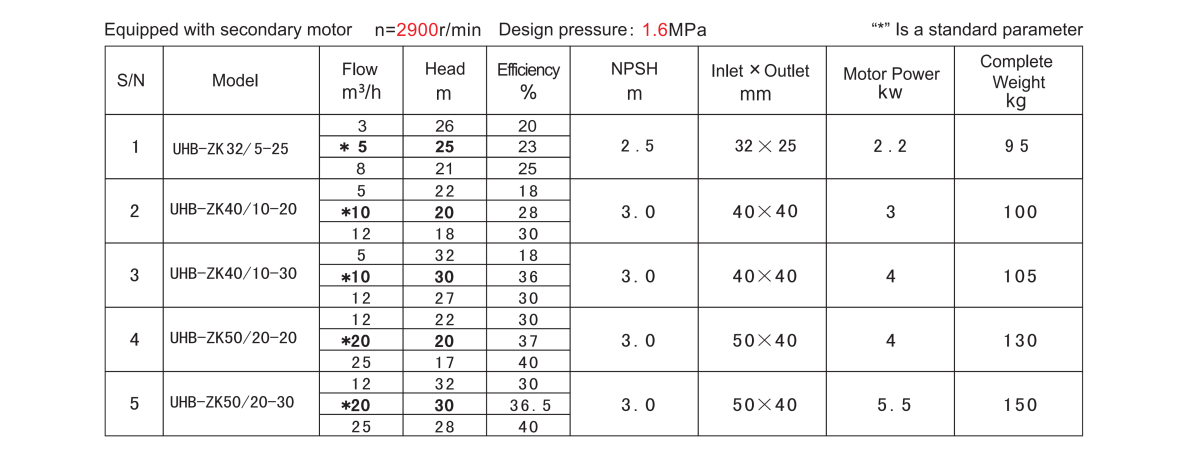
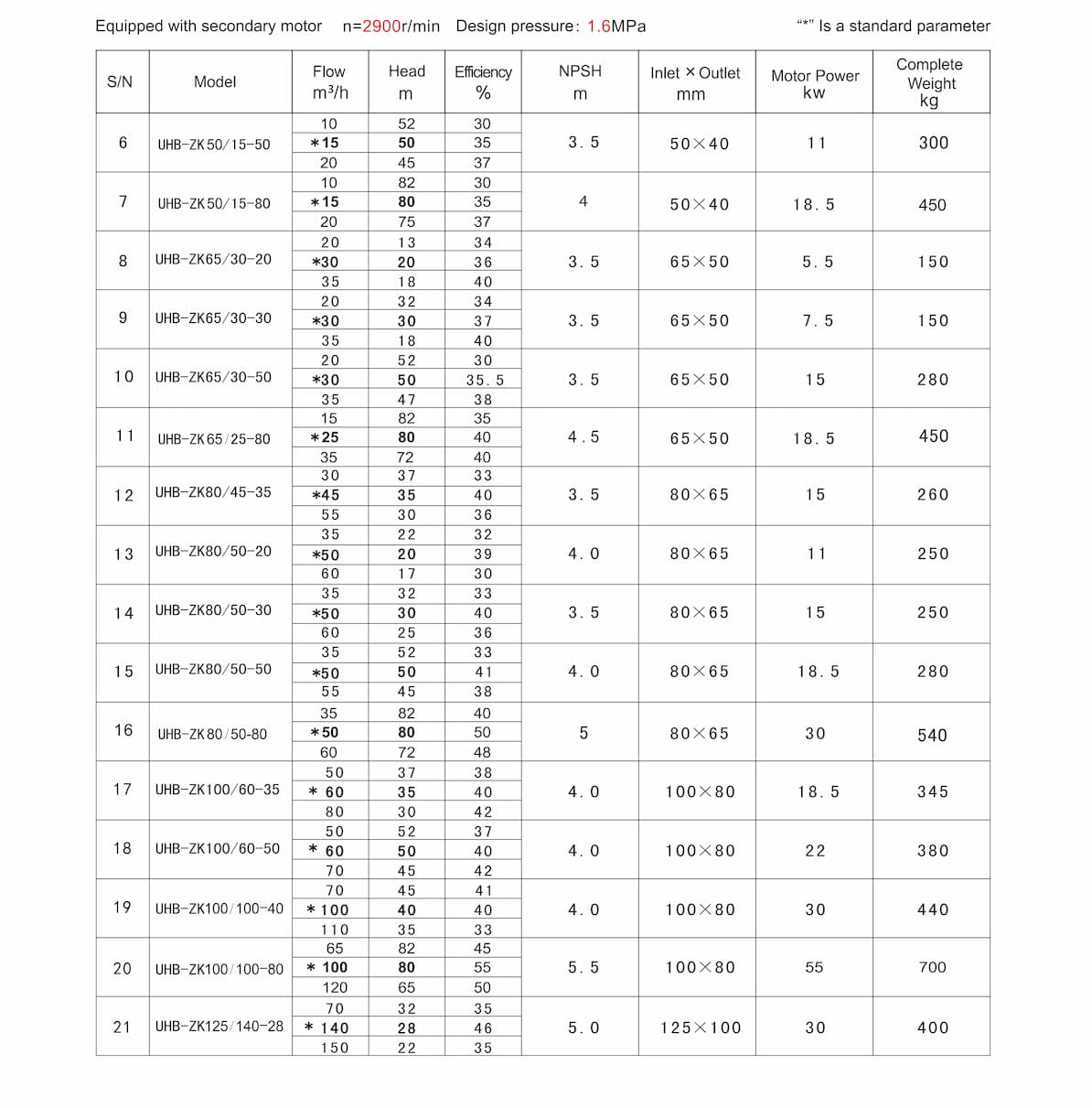
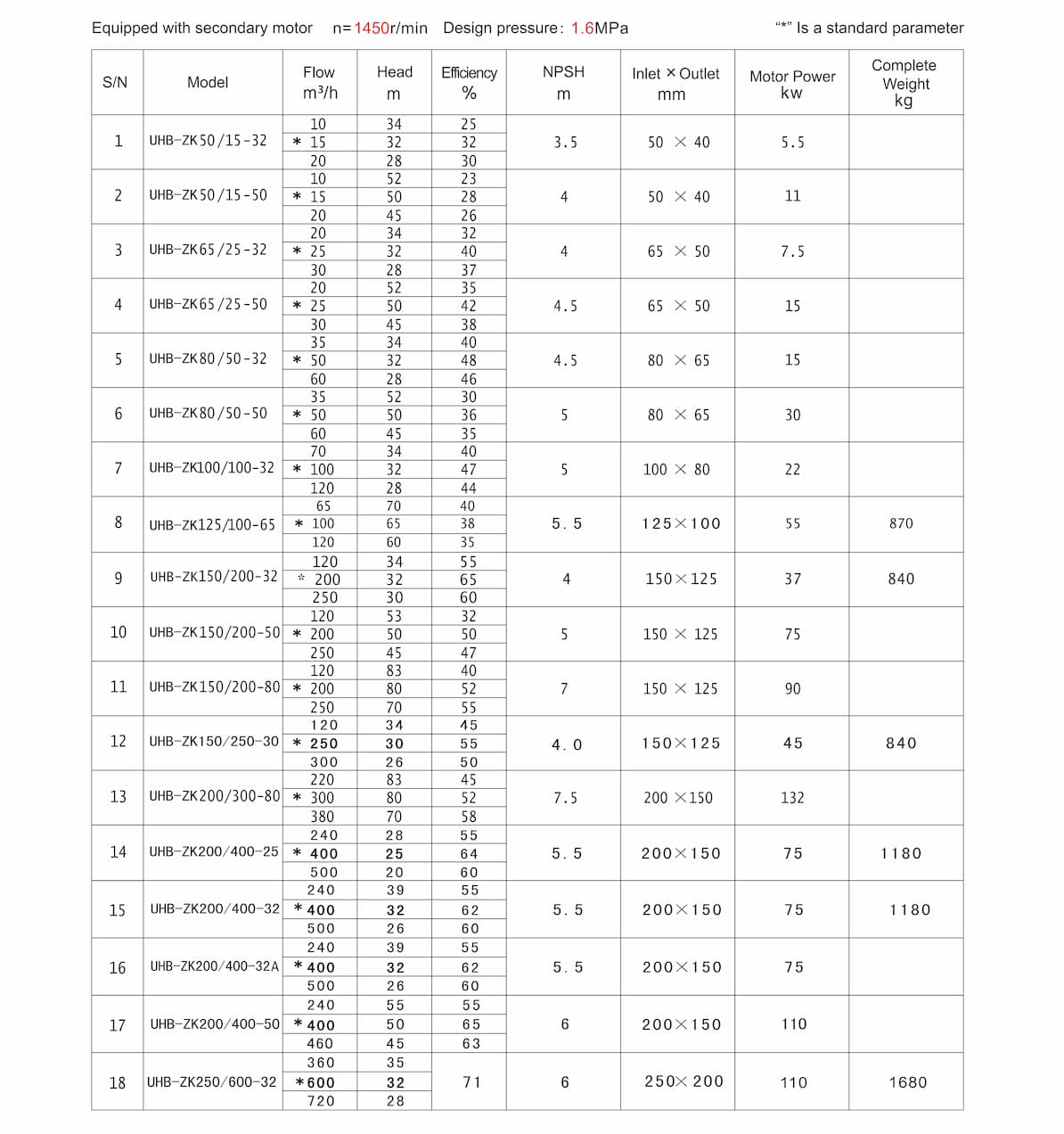
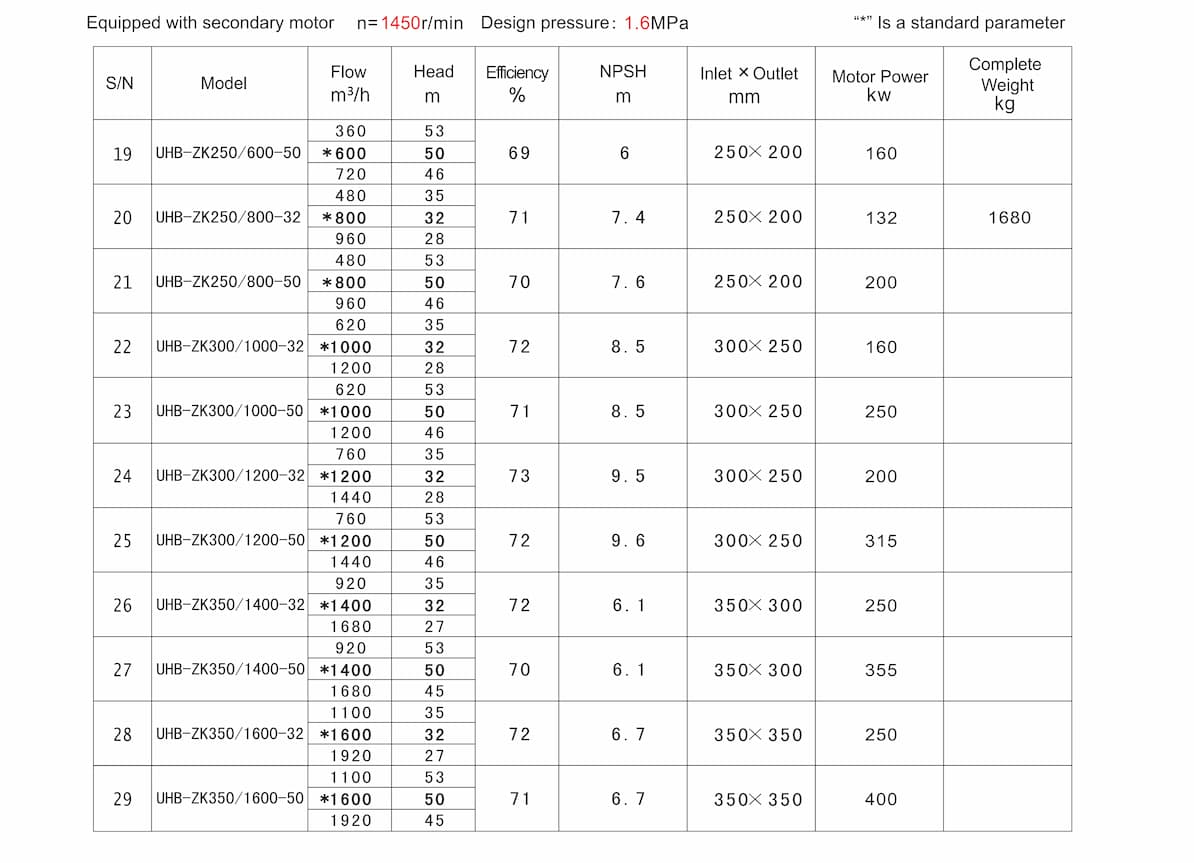


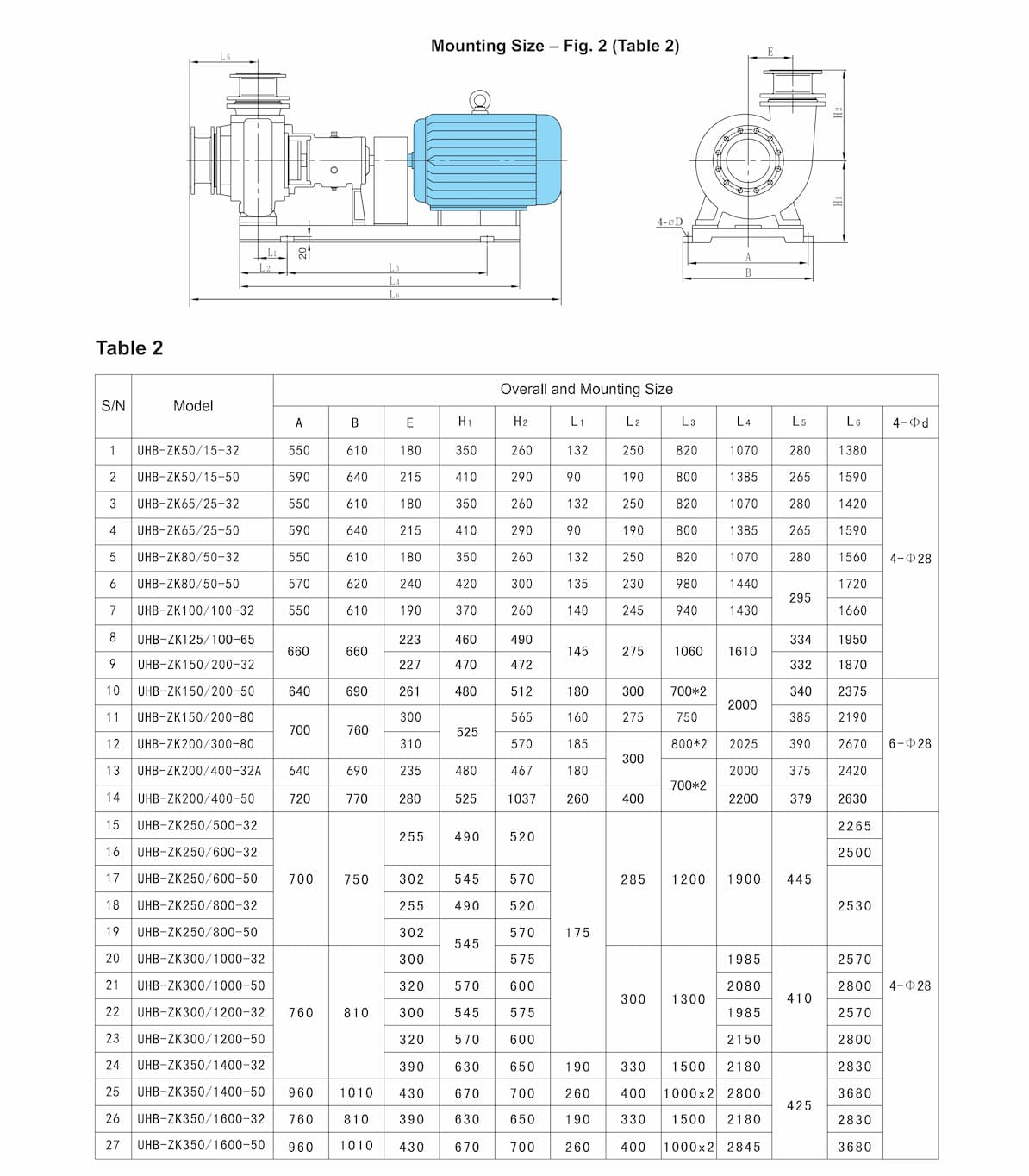
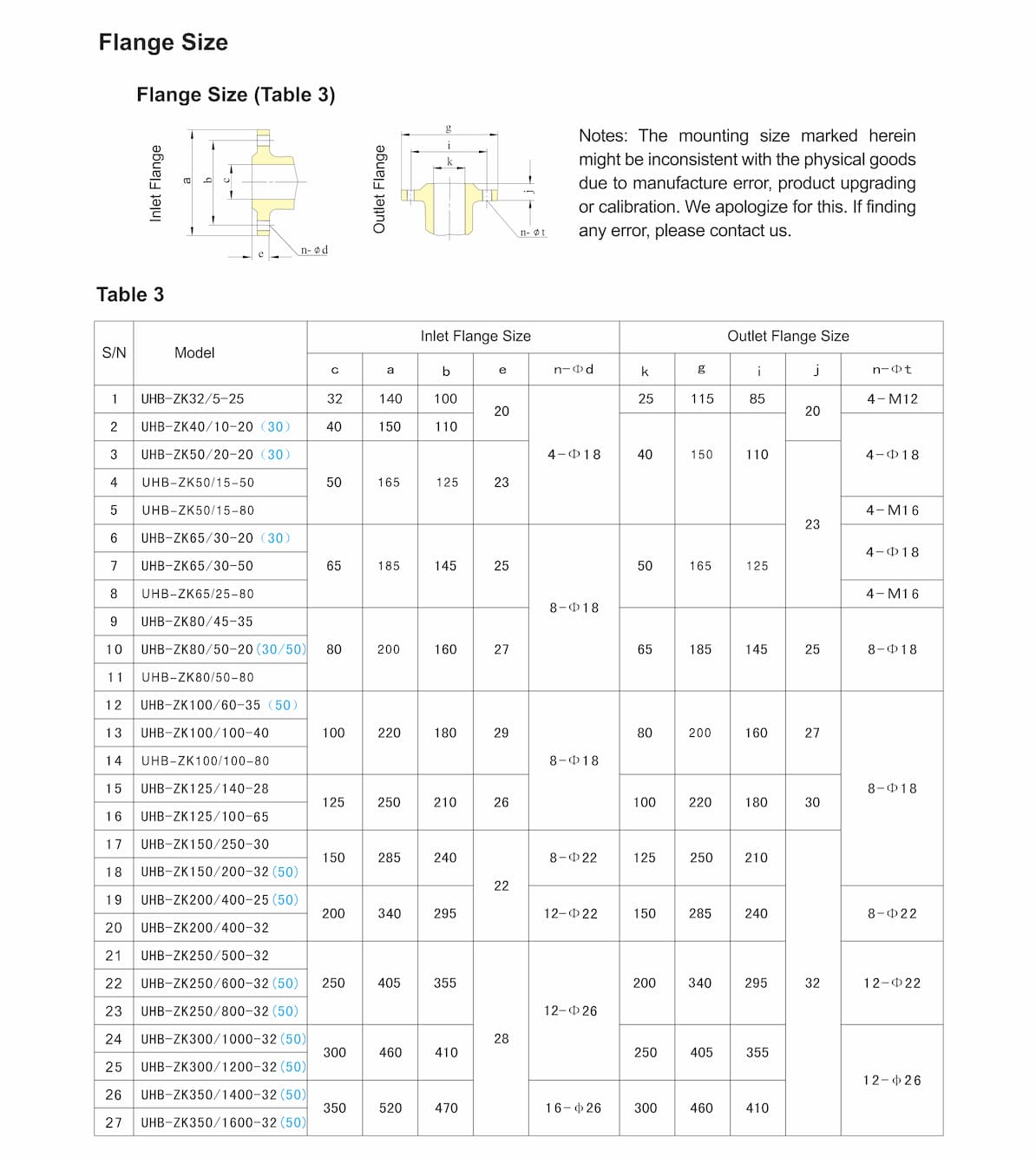
 Network Supported
Network Supported